The Frontiers of Nanomaterials (SnS, PbS and CuS) for Dye-Sensitized Solar Cell Applications: An Exciting New Infrared Material
Abstract
1. Introduction
2. Recent Advances in SnS, CuS and PbS QDs Synthesis
3. Overview of Single-Source Molecular Precursor Synthesis of QDs
3.1. PbS Quantum Dots
3.2. CuS Quantum Dots
3.3. SnS Quantum Dots
4. Molecular Precursor Complexes
4.1. Dithiocarbamate Cu(II) Complexes
4.2. Dithiocarbamate Pb(II) Complexes
4.3. Dithiocarbamate Sn(II) Complexes
5. Recent Advances in PbS, SnS and CuS Quantum Dot Application for Dye-Sensitized Solar Cells
5.1. Recent Advances in PbS Quantum Dots
5.2. Recent Advances in SnS Quantum Dots
5.3. Recent Advances in CuS Quantum Dots
6. Conclusions, Further Improvement and Future Studies
Author Contributions
Funding
Acknowledgments
Conflicts of Interest
References
- Yuksel, I. Renewable energy status of electricity generation and future prospect hydropower in Turkey. Renew. Energy 2013, 50, 1037–1043. [Google Scholar] [CrossRef]
- El Chaar, L.; El Zein, N. Review of photovoltaic technologies. Renew. Sustain. Energy Rev. 2011, 15, 2165–2175. [Google Scholar] [CrossRef]
- Shah, A.; Torres, P.; Tscharner, R.; Wyrsch, N.; Keppner, H. Photovoltaic technology: The case for thin-film solar cells. Science 1999, 285, 692–698. [Google Scholar] [CrossRef] [PubMed]
- Cook, T.R.; Dogutan, D.K.; Reece, S.Y.; Surendranath, Y.; Teets, T.S.; Nocera, D.G. Solar energy supply and storage for the legacy and non-legacy worlds. Chem. Rev. 2010, 110, 6474–6502. [Google Scholar] [CrossRef] [PubMed]
- Lewis, N.S. Toward cost-effective solar energy use. Science 2007, 315, 798–801. [Google Scholar] [CrossRef]
- Chebrolu, V.T.; Kim, H.J. Recent progress in quantum dot sensitized solar cells: An inclusive review of photoanode, sensitizer, electrolyte, and the counter electrode. J. Mater. Chem. C 2019, 7, 4911–4933. [Google Scholar] [CrossRef]
- Hossain, M.A.; Jennings, J.R.; Shen, C.; Pan, J.H.; Koh, Z.Y.; Mathews, N.; Wang, Q. CdSe-sensitized mesoscopic TiO2 solar cells exhibiting >5% efficiency: Redundancy of CdS buffer layer. J. Mater. Chem. 2012, 22, 16235–16242. [Google Scholar] [CrossRef]
- Kamat, P.V. Quantum dot solar cells. Semiconductor nanocrystals as light harvesters. J. Phys. Chem. C 2008, 112, 18737–18753. [Google Scholar] [CrossRef]
- Ma, W.; Swisher, S.L.; Ewers, T.; Engel, J.; Ferry, V.E.; Atwater, H.A.; Alivisatos, A.P. Photovoltaic performance of ultrasmall PbSe quantum dots. ACS Nano 2011, 5, 8140–8147. [Google Scholar] [CrossRef]
- Segets, D.; Lucas, J.M.; Klupp Taylor, R.N.; Scheele, M.; Zheng, H.; Alivisatos, A.P.; Peukert, W. Determination of the quantum dot band gap dependence on particle size from optical absorbance and transmission electron microscopy measurements. ACS Nano 2012, 6, 9021–9032. [Google Scholar] [CrossRef]
- Shockley, W.; Queisser, H.J. Detailed balance limit of efficiency of p-n junction solar cells. J. Appl. Phys. 1961, 32, 510–519. [Google Scholar] [CrossRef]
- Jørgensen, M.; Norrman, K.; Gevorgyan, S.A.; Tromholt, T.; Andreasen, B.; Krebs, F.C. Stability of polymer solar cells. Adv. Mater. 2012, 24, 580–612. [Google Scholar] [CrossRef] [PubMed]
- Zhu, J.; Yu, Z.; Burkhard, G.F.; Hsu, C.M.; Connor, S.T.; Xu, Y.; Wang, Q.; McGehee, M.; Fan, S.; Cui, Y. Optical absorption enhancement in amorphous silicon nanowire and nanocone arrays. Nano Lett. 2008, 9, 279–282. [Google Scholar] [CrossRef] [PubMed]
- Kim, M.R.; Ma, D. Quantum-dot-based solar cells: Recent advances, strategies, and challenges. J. Phys. Chem. Lett. 2014, 6, 85–99. [Google Scholar] [CrossRef] [PubMed]
- Yang, C.H.; Chen, P.Y.; Chen, W.J.; Wang, T.L.; Shieh, Y.T. Spectroscopic evidences of synergistic co-sensitization in dye-sensitized solar cells via experimentation of mixture design. Electrochim. Acta 2013, 107, 170–177. [Google Scholar] [CrossRef]
- Yang, L.; Leung, W.W.F.; Wang, J. Improvement in light harvesting in a dye sensitized solar cell based on cascade charge transfer. Nanoscale 2013, 5, 7493–7498. [Google Scholar] [CrossRef]
- Ye, M.; Gao, X.; Hong, X.; Liu, Q.; He, C.; Liu, X.; Lin, C. Recent advances in quantum dot-sensitized solar cells: Insights into photoanodes, sensitizers, electrolytes and counter electrodes. Sustain. Energy Fuels 2017, 1, 1217–1231. [Google Scholar] [CrossRef]
- Shrestha, A.; Batmunkh, M.; Tricoli, A.; Qiao, S.Z.; Dai, S. Near-infrared active lead chalcogenide quantum dots: preparation, post-synthesis ligand exchange, and applications in solar cells. Angew. Chem. Int. Ed. 2019, 58, 5202–5224. [Google Scholar] [CrossRef]
- Lim, J.; Bae, W.K.; Kwak, J.; Lee, S.; Lee, C.; Char, K. Perspective on synthesis, device structures, and printing processes for quantum dot displays. Opt. Mater. Express 2012, 2, 594–628. [Google Scholar] [CrossRef]
- Kershaw, S.V.; Susha, A.S.; Rogach, A.L. Narrow bandgap colloidal metal chalcogenide quantum dots: Synthetic methods, heterostructures, assemblies, electronic and infrared optical properties. Chem. Soc. Rev. 2013, 42, 3033–3087. [Google Scholar] [CrossRef]
- Owen, J.; Brus, L. Chemical synthesis and luminescence applications of colloidal semiconductor quantum dots. J. Am. Chem. Soc. 2017, 139, 10939–10943. [Google Scholar] [CrossRef] [PubMed]
- Van Embden, J.; Chesman, A.S.; Jasieniak, J.J. The heat-up synthesis of colloidal nanocrystals. Chem. Mater. 2015, 27, 2246–2285. [Google Scholar] [CrossRef]
- Goubet, N.; Jagtap, A.; Livache, C.; Martinez, B.; Portalès, H.; Xu, X.Z.; Lobo, R.P.; Dubertret, B.; Lhuillier, E. Terahertz HgTe nanocrystals: Beyond confinement. J. Am. Chem. Soc. 2018, 140, 5033–5036. [Google Scholar] [CrossRef] [PubMed]
- Ma, W.; Luther, J.M.; Zheng, H.; Wu, Y.; Alivisatos, A.P. Photovoltaic devices employing ternary PbSx Se1−x nanocrystals. Nano Lett. 2009, 9, 1699–1703. [Google Scholar] [CrossRef] [PubMed]
- Jäger-Waldau, A. Progress in chalcopyrite compound semiconductor research for photovoltaic applications and transfer of results into actual solar cell production. In Practical Handbook of Photovoltaics; Academic Press: Cambridge, MA, USA, 2012; pp. 373–395. [Google Scholar]
- Klenk, R.; Klaer, J.; Köble, C.; Mainz, R.; Merdes, S.; Rodriguez-Alvarez, H.; Scheer, R.; Schock, H.W. Development of CuInS2-based solar cells and modules. Sol. Energy Mater. Sol. Cells 2011, 95, 1441–1445. [Google Scholar] [CrossRef]
- Lai, C.H.; Lu, M.Y.; Chen, L.J. Metal sulfide nanostructures: Synthesis, properties and applications in energy conversion and storage. J. Mater. Chem. 2012, 22, 19–30. [Google Scholar] [CrossRef]
- Zhao, Y.; Burda, C. Development of plasmonic semiconductor nanomaterials with copper chalcogenides for a future with sustainable energy materials. Energy Environ. Sci. 2012, 5, 5564–5576. [Google Scholar] [CrossRef]
- Kim, H.J.; Myung-Sik, L.; Gopi, C.V.; Venkata-Haritha, M.; Rao, S.S.; Kim, S.K. Cost-effective and morphology controllable PVP based highly efficient CuS counter electrodes for high-efficiency quantum dot-sensitized solar cells. Dalton Trans. 2015, 44, 11340–11351. [Google Scholar] [CrossRef]
- Mousavi-Kamazani, M.; Zarghami, Z.; Salavati-Niasari, M. Facile and novel chemical synthesis, characterization, and formation mechanism of copper sulfide (Cu2S, Cu2S/CuS, CuS) nanostructures for increasing the efficiency of solar cells. J. Phys. Chem. C 2016, 120, 2096–2108. [Google Scholar] [CrossRef]
- Tian, J.; Shen, T.; Liu, X.; Fei, C.; Lv, L.; Cao, G. Enhanced performance of PbS-quantum-dot-sensitized solar cells via optimizing precursor solution and electrolytes. Sci. Rep. 2016, 6, 23094. [Google Scholar] [CrossRef]
- An, J.; Yang, X.; Wang, W.; Li, J.; Wang, H.; Yu, Z.; Gong, C.; Wang, X.; Sun, L. Stable and efficient PbS colloidal quantum dot solar cells incorporating low-temperature processed carbon paste counter electrodes. Sol. Energy 2017, 158, 28–33. [Google Scholar] [CrossRef]
- Li, H.; Ji, J.; Zheng, X.; Ma, Y.; Jin, Z.; Ji, H. Preparation of SnS quantum dots for solar cells application by an in-situ solution chemical reaction process. Mater. Sci. Semicond. Process. 2015, 36, 65–70. [Google Scholar] [CrossRef]
- Ngoi, K.K.; Jun, H.K. Study of fabrication of fully aqueous solution processed SnS quantum dot-sensitized solar cell. Green Process. Synth. 2019, 8, 443–450. [Google Scholar] [CrossRef]
- Wu, Y.; Wadia, C.; Ma, W.; Sadtler, B.; Alivisatos, A.P. Synthesis and photovoltaic application of copper (I) sulfide nanocrystals. Nano Lett. 2008, 8, 2551–2555. [Google Scholar] [CrossRef] [PubMed]
- Zhao, Y.; Pan, H.; Lou, Y.; Qiu, X.; Zhu, J.; Burda, C. Plasmonic Cu2−x S nanocrystals: Optical and structural properties of copper-deficient copper (I) sulfides. J. Am. Chem. Soc. 2009, 131, 4253–4261. [Google Scholar] [CrossRef] [PubMed]
- Chen, Y.B.; Chen, L.; Wu, L.M. The structure-controlling solventless synthesis and optical properties of uniform Cu2s nanodisks. Chem. Eur. J. 2008, 14, 11069–11075. [Google Scholar] [CrossRef]
- Spalatu, N.; Hiie, J.; Kaupmees, R.; Volobujeva, O.; Krustok, J.; Oja Acik, I.; Krunks, M. Post-deposition processing of SnS thin films and solar cells: prospective strategy to obtain large, sintered and doped sns grains by recrystallization in the presence of a metal halide Flux. ACS Appl. Mater. 2019, 11, 17539–17554. [Google Scholar] [CrossRef]
- Abdelhady, A.L.; Ramasamy, K.; Malik, M.A.; O’Brien, P.; Haigh, S.J.; Raftery, J. New routes to copper sulfide nanostructures and thin films. J. Mater. Chem. 2011, 21, 17888–17895. [Google Scholar] [CrossRef]
- Hickey, S.G.; Waurisch, C.; Rellinghaus, B.; Eychmüller, A. Size and shape control of colloidally synthesized IV−VI nanoparticulate tin (II) sulfide. J. Am. Chem. Soc. 2008, 130, 14978–14980. [Google Scholar] [CrossRef]
- Liu, H.; Liu, Y.; Wang, Z.; He, P. Facile synthesis of monodisperse, size-tunable SnS nanoparticles potentially for solar cell energy conversion. Nanotechnology 2010, 21, 105707. [Google Scholar] [CrossRef]
- Ramasamy, K.; Malik, M.A.; Revaprasadu, N.; O’Brien, P. Routes to nanostructured inorganic materials with potential for solar energy applications. J. Mater. Chem. 2013, 25, 3551–3569. [Google Scholar] [CrossRef]
- Oda, Y.; Shen, H.; Zhao, L.; Li, J.; Iwamoto, M.; Lin, H. Energetic alignment in nontoxic SnS quantum dot-sensitized solar cell employing spiro-OMeTAD as the solid-state electrolyte. Sci. Technol. Adv. Mater. 2014, 15, 035006. [Google Scholar] [CrossRef] [PubMed][Green Version]
- Bai, B.; Kou, D.; Zhou, W.; Zhou, Z.; Tian, Q.; Meng, Y.; Wu, S. Quaternary Cu2ZnSnS4 quantum dot-sensitized solar cells: Synthesis, passivation and ligand exchange. J. Power Sources 2016, 318, 35–40. [Google Scholar] [CrossRef]
- Jiao, S.; Wang, J.; Shen, Q.; Li, Y.; Zhong, X. Surface engineering of PbS quantum dot sensitized solar cells with a conversion efficiency exceeding 7%. J. Mater. Chem. A 2016, 4, 7214–7221. [Google Scholar] [CrossRef]
- Cademartiri, L.; Bertolotti, J.; Sapienza, R.; Wiersma, D.S.; Von Freymann, G.; Ozin, G.A. Multigram scale, solventless, and diffusion-controlled route to highly monodisperse PbS nanocrystals. J. Phys. Chem. B 2006, 110, 671–673. [Google Scholar] [CrossRef]
- Liu, J.; Yu, H.; Wu, Z.; Wang, W.; Peng, J.; Cao, Y. Size-tunable near-infrared PbS nanoparticles synthesized from lead carboxylate and sulfur with oleylamine as stabilizer. Nanotechnology 2008, 19, 345602. [Google Scholar] [CrossRef]
- Hines, M.A.; Scholes, G.D. Colloidal PbS nanocrystals with size-tunable near-infrared emission: Observation of post-synthesis self-narrowing of the particle size distribution. Adv. Mater. 2003, 15, 1844–1849. [Google Scholar] [CrossRef]
- Carey, G.H.; Abdelhady, A.L.; Ning, Z.; Thon, S.M.; Bakr, O.M.; Sargent, E.H. Colloidal quantum dot solar cells. Chem. Rev. 2015, 115, 12732–12763. [Google Scholar] [CrossRef]
- Manukumar, K.N.; Nagaraju, G.; Kishore, B.; Madhu, C.; Munichandraiah, N. Ionic liquid-assisted hydrothermal synthesis of SnS nanoparticles: Electrode materials for lithium batteries, photoluminescence and photocatalytic activities. J. Energy Chem. 2018, 27, 806–812. [Google Scholar] [CrossRef]
- Chauhan, H.; Singh, M.K.; Hashmi, S.A.; Deka, S. Synthesis of surfactant-free SnS nanorods by a solvothermal route with better electrochemical properties towards supercapacitor applications. RSC Adv. 2015, 5, 17228–17235. [Google Scholar] [CrossRef]
- Nørby, P.; Johnsen, S.; Iversen, B.B. Fine tunable aqueous solution synthesis of textured flexible SnS2 thin films and nanosheets. Phys. Chem. Chem. Phys. 2015, 17, 9282–9287. [Google Scholar] [CrossRef] [PubMed]
- Dai, X.; Shi, C.; Zhang, Y.; Liu, F.; Fang, X.; Zhu, J. SnS thin film prepared by pyrolytic synthesis as an efficient counter electrode in quantum dot sensitized solar cells. J. Nanosci. Nanotechnol. 2015, 15, 6813–6817. [Google Scholar] [CrossRef] [PubMed]
- Yin, D.; Liu, Y.; Dun, C.; Carroll, D.L.; Swihart, M.T. Controllable colloidal synthesis of anisotropic tin dichalcogenide nanocrystals for thin film thermoelectrics. Nanoscale 2018, 10, 2533–2541. [Google Scholar] [CrossRef] [PubMed]
- Thompson, J.R.; Ahmet, I.Y.; Johnson, A.L.; Kociok-Köhn, G. Tin (IV) chalcogenide complexes: Single source precursors for SnS, SnSe and SnTe nanoparticle synthesis. Eur. J. Inorg. Chem. 2016, 2016, 4711–4720. [Google Scholar] [CrossRef]
- Kevin, P.; Lewis, D.J.; Raftery, J.; Malik, M.A.; O’Brien, P. Thin films of tin (II) sulphide (SnS) by aerosol-assisted chemical vapour deposition (AACVD) using tin (II) dithiocarbamates as single-source precursors. J. Cryst. Growth 2015, 415, 93–99. [Google Scholar] [CrossRef]
- Henry, J.; Mohanraj, K.; Kannan, S.; Barathan, S.; Sivakumar, G. Structural and optical properties of SnS nanoparticles and electron-beam-evaporated SnS thin films. J. Exp. Nanosci. 2015, 10, 78–85. [Google Scholar] [CrossRef]
- Park, S.; Park, J.; Selvaraj, R.; Kim, Y. Facile microwave-assisted synthesis of SnS2 nanoparticles for visible-light responsive photocatalyst. J. Ind. Eng. Chem. 2015, 31, 269–275. [Google Scholar] [CrossRef]
- Lin, Y.T.; Shi, J.B.; Chen, Y.C.; Chen, C.J.; Wu, P.F. Synthesis and characterization of tin disulfide (SnS2) nanowires. Nanoscale Res. Lett. 2009, 4, 694. [Google Scholar] [CrossRef]
- Oluwalana, A.E.; Ajibade, P.A. Effect of temperature and capping agents on structural and optical properties of tin sulphide nanocrystals. J. Nanotechnol. 2019, 2019, 11. [Google Scholar] [CrossRef]
- Hou, B.; Cho, Y.; Kim, B.S.; Hong, J.; Park, J.B.; Ahn, S.J.; Sohn, J.I.; Cha, S.; Kim, J.M. Highly monodispersed PbS quantum dots for outstanding cascaded-junction solar cells. ACS Energy Lett. 2016, 1, 834–839. [Google Scholar] [CrossRef]
- Boadi, N.O.; Malik, M.A.; O’Brien, P.; Awudza, J.A. Single source molecular precursor routes to lead chalcogenides. Dalton Trans. 2012, 41, 10497–10506. [Google Scholar] [CrossRef] [PubMed]
- Lee, S.M.; Jun, Y.W.; Cho, S.N.; Cheon, J. Single-crystalline star-shaped nanocrystals and their evolution: Programming the geometry of nano-building blocks. J. Am. Chem. Soc. 2002, 124, 11244–11245. [Google Scholar] [CrossRef] [PubMed]
- Ratanatawanate, C.; Bui, A.; Vu, K.; Balkus Jr, K.J. Low-temperature synthesis of copper (II) sulfide quantum dot decorated TiO2 nanotubes and their photocatalytic properties. J. Phys. Chem. C 2011, 115, 6175–6180. [Google Scholar] [CrossRef]
- Zhang, S.; Zhong, H.; Ding, C. Ultrasensitive flow injection chemiluminescence detection of DNA hybridization using signal DNA probe modified with Au and CuS nanoparticles. Anal. Chem. 2008, 80, 7206–7212. [Google Scholar] [CrossRef]
- Li, Y.; Lu, W.; Huang, Q.; Li, C.; Chen, W. Copper sulfide nanoparticles for photothermal ablation of tumor cells. Nanomedicine 2010, 5, 1161–1171. [Google Scholar] [CrossRef]
- Li, B.; Xie, Y.; Xue, Y. Controllable synthesis of CuS nanostructures from self-assembled precursors with biomolecule assistance. J. Phys. Chem. C 2007, 111, 12181–12187. [Google Scholar] [CrossRef]
- Luther, J.M.; Jain, P.K.; Ewers, T.; Alivisatos, A.P. Localized surface plasmon resonances arising from free carriers in doped quantum dots. Nat. Mater. 2011, 10, 361. [Google Scholar] [CrossRef]
- Mary, K.A.; Unnikrishnan, N.V.; Philip, R. Role of surface states and defects in the ultrafast nonlinear optical properties of CuS quantum dots. APL Mater. 2014, 2, 076104. [Google Scholar] [CrossRef]
- Rahaman, S.; Jagannatha, K.B.; Sriram, A. Synthesis and Characterization of SnS Quantum Dots materialfor Solar Cell. Mater. Today Proc. 2018, 5, 3117–3120. [Google Scholar] [CrossRef]
- Buenzli, J.C.G. On the design of highly luminescent lanthanide complexes. Coord. Chem. Rev. 2015, 293, 19–47. [Google Scholar] [CrossRef]
- Deng, Z.; Han, D.; Liu, Y. Colloidal synthesis of metastable zinc-blende IV–VI SnS nanocrystals with tunable 493 sizes. Nanoscale 2011, 3, 4346–4351. [Google Scholar] [CrossRef] [PubMed]
- Nagai, H.; Sato, M. Heat treatment in molecular precursor method for fabricating metal oxide thin films. In Heat Treatment—Conventional and Novel Applications; Czerwinski, F., Ed.; InTech Open: London, UK, 2012; pp. 297–322. [Google Scholar]
- Nagai, H.; Sato, M. Molecular precursor method for fabricating p-Type Cu2O and metallic Cu thin films. In Modern Technologys Creating Thin-Film Systems and Coatings; InTech Open: London, UK, 2017; pp. 3–20. [Google Scholar]
- Moreau, F.; Audebrand, N.; Poriel, C.; Moizan-Baslé, V.; Ouvry, J. A 9, 9′-spirobifluorene based Metal–Organic Framework: Synthesis, structure analysis and gas sorption properties. J. Mater. Chem. 2011, 21, 18715–18722. [Google Scholar] [CrossRef]
- Le Natur, F.; Calvez, G.; Freslon, S.; Daiguebonne, C.; Bernot, K.; Guillou, O. Extending the lanthanide–terephthalate system: Isolation of an unprecedented Tb (III)-based coordination polymer with high potential porosity and luminescence properties. J. Mol. Struct. 2015, 1086, 34–42. [Google Scholar] [CrossRef]
- Luo, Y.; Bernot, K.; Calvez, G.; Freslon, S.; Daiguebonne, C.; Guillou, O.; Kerbellec, N.; Roisnel, T. 1, 2, 4, 5-Benzene-tetra-carboxylic acid: A versatile ligand for high dimensional lanthanide-based coordination polymers. Cryst. Eng. Commun. 2013, 15, 1882–1896. [Google Scholar] [CrossRef]
- Plyusnin, V.F.; Kolomeets, A.V.; Grivin, V.P.; Larionov, S.V.; Lemmetyinen, H. Photochemistry of dithiocarbamate Cu (II) complex in CCl4. J. Phys. Chem. A 2011, 115, 1763–1773. [Google Scholar] [CrossRef]
- Vickers, M.S.; Cookson, J.; Beer, P.D.; Bishop, P.T.; Thiebaut, B. Dithiocarbamate ligand stabilised gold nanoparticles. J. Mater. Chem. 2006, 16, 209–215. [Google Scholar] [CrossRef]
- De Lima, G.M.; Menezes, D.C.; Cavalcanti, C.A.; Dos Santos, J.A.; Ferreira, I.P.; Paniago, E.B.; Wardell, J.L.; Wardell, S.M.; Krambrock, K.; Mendes, I.C.; et al. Synthesis, characterisation and biological aspects of copper (II) dithiocarbamate complexes, [Cu {S2CNR (CH2CH2OH)} 2],(R= Me, Et, Pr and CH2CH2OH). J. Mol. Struct. 2011, 988, 1–8. [Google Scholar] [CrossRef]
- Gaudernak, E.; Seipelt, J.; Triendl, A.; Grassauer, A.; Kuechler, E. Antiviral effects of pyrrolidine dithiocarbamate on human rhinoviruses. J. Virol. 2002, 76, 6004–6015. [Google Scholar] [CrossRef]
- Zamora-Moreno, J.; Montiel-Palma, V. Versatile silylphosphine ligands for transition metal complexation. In Ligand; Intech Open: London, UK, 2018. [Google Scholar]
- Trindade, T.; O’Brien, P.; Zhang, X.M.; Motevalli, M. Synthesis of PbS nanocrystallites using a novel single molecule precursors approach: X-ray single-crystal structure of Pb (S2CNEtPri) 2. J. Mater. Chem. 1997, 7, 1011–1016. [Google Scholar] [CrossRef]
- Mandal, T.; Piburn, G.; Stavila, V.; Rusakova, I.; Ould-Ely, T.; Colson, A.C.; Whitmire, K.H. New mixed ligand single-source precursors for PbS nanoparticles and their solvothermal decomposition to anisotropic nano-and microstructures. Chem. Mater. 2011, 23, 4158–4169. [Google Scholar] [CrossRef]
- Salavati-Niasari, M.; Sobhani, A.; Davar, F. Synthesis of star-shaped PbS nanocrystals using single-source precursor. J. Alloys Compd. 2010, 507, 77–83. [Google Scholar] [CrossRef]
- Lewis, D.J.; Kevin, P.; Bakr, O.; Muryn, C.A.; Malik, M.A.; O’Brien, P. Routes to tin chalcogenide materials as thin films or nanoparticles: A potentially important class of semiconductor for sustainable solar energy conversion. Inorg. Chem. Front. 2014, 1, 577–598. [Google Scholar] [CrossRef]
- Malik, M.A.; Afzaal, M.; O’Brien, P. Precursor chemistry for main group elements in semiconducting materials. Chem. Rev. 2010, 110, 4417–4446. [Google Scholar] [CrossRef] [PubMed]
- Lewis, D.J.; Tedstone, A.A.; Zhong, X.L.; Lewis, E.A.; Rooney, A.; Savjani, N.; Brent, J.R.; Haigh, S.J.; Burke, M.G.; Muryn, C.A.; et al. Thin films of molybdenum disulfide doped with chromium by aerosol-assisted chemical vapor deposition (AACVD). Chem. Mater. 2015, 27, 1367–1374. [Google Scholar] [CrossRef]
- Sun, J.K.; Jiang, Y.; Zhong, X.; Hu, J.S.; Wan, L.J. Three-dimensional nanostructured electrodes for efficient quantum-dot-sensitized solar cells. Nano Energy 2017, 32, 130–156. [Google Scholar] [CrossRef]
- Kumar, S.; Nehra, M.; Deep, A.; Kedia, D.; Dilbaghi, N.; Kim, K.H. Quantum-sized nanomaterials for solar cell applications. Renew. Sustain. Energy Rev. 2017, 73, 821–839. [Google Scholar] [CrossRef]
- Yu, W.W.; Qu, L.; Guo, W.; Peng, X. Experimental determination of the extinction coefficient of CdTe, CdSe, and CdS nanocrystals. Chem. Mater. 2003, 15, 2854–2860. [Google Scholar] [CrossRef]
- Vogel, R.; Hoyer, P.; Weller, H. Quantum-sized PbS, CdS, Ag2S, Sb2S3, and Bi2S3 particles as sensitizers for various nanoporous wide-bandgap semiconductors. J. Phys. Chem. 1994, 98, 3183–3188. [Google Scholar] [CrossRef]
- Luther, J.M.; Beard, M.C.; Song, Q.; Law, M.; Ellingson, R.J.; Nozik, A.J. Multiple exciton generation in films of electronically coupled PbSe quantum dots. Nano Lett. 2007, 7, 1779–1784. [Google Scholar] [CrossRef]
- Yang, Z.; Chen, C.Y.; Roy, P.; Chang, H.T. Quantum dot-sensitized solar cells incorporating nanomaterials. Chem. Commun. 2011, 47, 9561–9571. [Google Scholar] [CrossRef]
- Zhao, K.; Pan, Z.; Mora-Seró, I.; Cánovas, E.; Wang, H.; Song, Y.; Gong, X.; Wang, J.; Bonn, M.; Bisquert, J.; et al. Boosting power conversion efficiencies of quantum-dot-sensitized solar cells beyond 8% by recombination control. J. Am. Chem. Soc. 2015, 137, 5602–5609. [Google Scholar] [CrossRef] [PubMed]
- Ren, Z.; Wang, Z.; Wang, R.; Pan, Z.; Gong, X.; Zhong, X. Effects of metal oxyhydroxide coatings on photoanode in quantum dot sensitized solar cells. Chem. Mater. 2016, 28, 2323–2330. [Google Scholar] [CrossRef]
- Du, Z.; Pan, Z.; Fabregat-Santiago, F.; Zhao, K.; Long, D.; Zhang, H.; Zhao, Y.; Zhong, X.; Yu, J.S.; Bisquert, J. Carbon counter-electrode-based quantum-dot-sensitized solar cells with certified efficiency exceeding 11%. J. Phys. Chem. Lett. 2016, 7, 3103–3111. [Google Scholar] [CrossRef] [PubMed]
- Jiao, S.; Du, J.; Du, Z.; Long, D.; Jiang, W.; Pan, Z.; Li, Y.; Zhong, X. Nitrogen-doped mesoporous carbons as counter electrodes in quantum dot sensitized solar cells with a conversion efficiency exceeding 12%. J. Phys. Chem. Lett. 2017, 8, 559–564. [Google Scholar] [CrossRef]
- Kowshik, M.; Vogel, W.; Urban, J.; Kulkarni, S.K.; Paknikar, K.M. Microbial synthesis of semiconductor PbS nanocrystallites. Adv. Mater. 2002, 14, 815–818. [Google Scholar] [CrossRef]
- Díaz, S.A.; Gillanders, F.; Jares-Erijman, E.A.; Jovin, T.M. Photoswitchable semiconductor nanocrystals with self-regulating photochromic Förster resonance energy transfer acceptors. Nat. Commun. 2015, 6, 6036. [Google Scholar] [CrossRef]
- Gong, X.; Yang, Z.; Walters, G.; Comin, R.; Ning, Z.; Beauregard, E.; Adinolfi, V.; Voznyy, O.; Sargent, E.H. Highly efficient quantum dot near-infrared light-emitting diodes. Nat. Photonics 2016, 10, 253. [Google Scholar] [CrossRef]
- Galian, R.E.; De la Guardia, M. The use of quantum dots in organic chemistry. Trends Anal. Chem. 2009, 28, 279–291. [Google Scholar] [CrossRef]
- Crisp, R.W.; Kroupa, D.M.; Marshall, A.R.; Miller, E.M.; Zhang, J.; Beard, M.C.; Luther, J.M. Metal halide solid-state surface treatment for high efficiency PbS and PbSe QD solar cells. Sci. Rep. 2015, 5, 9945. [Google Scholar] [CrossRef]
- Sasaki, A.; Tsukasaki, Y.; Komatsuzaki, A.; Sakata, T.; Yasuda, H.; Jin, T. Recombinant protein (EGFP-Protein G)-coated PbS quantum dots for in vitro and in vivo dual fluorescence (visible and second-NIR) imaging of breast tumors. Nanoscale 2015, 7, 5115–5119. [Google Scholar] [CrossRef]
- Kong, Y.; Chen, J.; Fang, H.; Heath, G.; Wo, Y.; Wang, W.; Li, Y.; Guo, Y.; Evans, S.D.; Chen, S.; et al. Highly fluorescent ribonuclease-A-encapsulated lead sulfide quantum dots for ultrasensitive fluorescence in vivo imaging in the second near-infrared window. Chem. Mater. 2016, 28, 3041–3050. [Google Scholar] [CrossRef] [PubMed]
- Chen, J.; Kong, Y.; Feng, S.; Chen, C.; Wo, Y.; Wang, W.; Dong, Y.; Wu, Z.; Li, Y.; Chen, S. Recycled synthesis of whey-protein-capped lead sulfide quantum dots as the second near-infrared reporter for bioimaging application. ACS Sustain. Chem. Eng. 2016, 4, 2932–2938. [Google Scholar] [CrossRef]
- Freyria, F.S.; Cordero, J.M.; Caram, J.R.; Doria, S.; Dodin, A.; Chen, Y.; Willard, A.P.; Bawendi, M.G. Near-infrared quantum dot emission enhanced by stabilized self-assembled j-aggregate antennas. Nano Lett. 2017, 17, 7665–7674. [Google Scholar] [CrossRef]
- Zhao, P.; Xu, Q.; Tao, J.; Jin, Z.; Pan, Y.; Yu, C.; Yu, Z. Near infrared quantum dots in biomedical applications: Current status and future perspective. Wiley Interdiscip. Rev. Nanomed. Nanobiotechnol. 2018, 10, 1483. [Google Scholar] [CrossRef]
- Yang, T.; Tang, Y.A.; Liu, L.; Lv, X.; Wang, Q.; Ke, H.; Deng, Y.; Yang, H.; Yang, X.; Liu, G.; et al. Size-dependent Ag2S nanodots for second near-infrared fluorescence/photoacoustics imaging and simultaneous photothermal therapy. ACS Nano 2017, 11, 1848–1857. [Google Scholar] [CrossRef] [PubMed]
- Xu, F.; Gerlein, L.; Ma, X.; Haughn, C.; Doty, M.; Cloutier, S. Impact of different surface ligands on the optical properties of PbS quantum dot solids. Materials 2015, 8, 1858–1870. [Google Scholar] [CrossRef]
- Thulasi-Varma, C.V.; Rao, S.S.; Ikkurthi, K.D.; Kim, S.K.; Kang, T.S.; Kim, H.J. Enhanced photovoltaic performance and morphological control of the PbS counter electrode grown on functionalized self-assembled nanocrystals for quantum-dot sensitized solar cells via cost-effective chemical bath deposition. J. Mater. Chem. C 2015, 3, 10195–10206. [Google Scholar] [CrossRef]
- Deepa, K.G.; Nagaraju, J. Development of SnS quantum dot solar cells by SILAR method. Mater. Sci. Semicond. Process. 2014, 27, 649–653. [Google Scholar] [CrossRef]
- Wang, W.; Shen, H.; Yao, H.; Li, J.; Jiao, J. Influence of solution temperature on the properties of Cu2 ZnSnS4 nanoparticles by ultrasound-assisted microwave irradiation. J. Mater. Sci. Mater. Electron. 2015, 26, 1449–1454. [Google Scholar] [CrossRef]
- Tang, P.; Chen, H.; Cao, F.; Pan, G.; Wang, K.; Xu, M.; Tong, Y. Nanoparticulate SnS as an efficient photocatalyst under visible-light irradiation. Mater. Lett. 2011, 65, 450–452. [Google Scholar] [CrossRef]
- Das, D.; Dutta, R.K. A novel method of synthesis of small band gap SnS nanorods and its efficient photocatalytic dye degradation. J. Colloid Interface Sci. 2015, 457, 339–344. [Google Scholar] [CrossRef] [PubMed]
- Koyasu, S.; Atarashi, D.; Sakai, E.; Miyauchi, M. Copper sulfide catalyzed porous fluorine-doped tin oxide counter electrode for quantum dot-sensitized solar cells with high fill factor. Int. J. Photoenergy 2017, 2017, 9. [Google Scholar] [CrossRef]
- Kim, H.J.; Ko, B.; Gopi, C.V.; Venkata-Haritha, M.; Lee, Y.S. Facile synthesis of morphology dependent CuS nanoparticle thin film as a highly efficient counter electrode for quantum dot-sensitized solar cells. J. Electroanal. Chem. 2017, 791, 95–102. [Google Scholar] [CrossRef]
- Punnoose, D.; Kumar, C.S.P.; Rao, S.S.; Varma, C.V.T.; Naresh, B.; Reddy, A.E.; Kundarala, N.; Lee, Y.S.; Kim, M.Y.; Kim, H.J. In situ synthesis of CuS nano platelets on nano wall networks of Ni foam and its application as an efficient counter electrode for quantum dot sensitized solar cells. Org. Electron. 2017, 42, 115–122. [Google Scholar] [CrossRef]
- Palve, B.M.; Kadam, V.S.; Jagtap, C.V.; Jadkar, S.R.; Pathan, H.M. A simple chemical route to synthesis the CuSe and CuS counter electrodes for titanium oxide based quantum dot solar cells. J. Mater. Sci. Mater. Electron. 2017, 28, 14394–14401. [Google Scholar] [CrossRef]
- Wang, X.; Wang, S.; Xie, Y.; Jiao, Y.; Liu, J.; Wang, X.; Zhou, W.; Xing, Z.; Pan, K. Facet-Dependent SnS Nanocrystals as the High-Performance Counter Electrode Materials for Dye-Sensitized Solar Cells. ACS Sustain. Chem. Eng. 2019, 7, 14353–14360. [Google Scholar] [CrossRef]
- Gopi, C.V.; Bae, J.H.; Venkata-Haritha, M.; Kim, S.K.; Lee, Y.S.; Sarat, G.; Kim, H.J. One-step synthesis of solution processed time-dependent highly efficient and stable PbS counter electrodes for quantum dot-sensitized solar cells. RSC Adv. 2015, 5, 107522–107532. [Google Scholar] [CrossRef]
- Lu, K.; Wang, Y.; Yuan, J.; Cui, Z.; Shi, G.; Shi, S.; Han, L.; Chen, S.; Zhang, Y.; Ling, X.; et al. Efficient PbS quantum dot solar cells employing a conventional structure. J. Mater. Chem. A 2017, 5, 23960–23966. [Google Scholar] [CrossRef]
- Ahmet, I.Y.; Guc, M.; Sánchez, Y.; Neuschitzer, M.; Izquierdo-Roca, V.; Saucedo, E.; Johnson, A.L. Evaluation of AA-CVD deposited phase pure polymorphs of SnS for thin films solar cells. RSC Adv. 2019, 9, 14899–14909. [Google Scholar] [CrossRef]
- Mohammadnezhad, M.; Selopal, G.S.; Alsayyari, N.; Akilimali, R.; Navarro-Pardo, F.; Wang, Z.M.; Stansfield, B.; Zhao, H.; Rosei, F. CuS/graphene nanocomposite as a transparent conducting oxide and pt-free counter electrode for dye-sensitized solar cells. J. Electrochem. Soc. 2019, 166, 3065–3073. [Google Scholar] [CrossRef]
- Dou, Y.; Zhou, R.; Wan, L.; Niu, H.; Zhou, J.; Xu, J.; Cao, G. Nearly monodisperse PbS quantum dots for highly efficient solar cells: An in situ seeded ion exchange approach. Chem. Commun. 2018, 54, 12598–12601. [Google Scholar] [CrossRef] [PubMed]
- Kwon, O.H.; Heo, J.H.; Park, S.; Kim, S.W.; Im, S.H. High performance solid-state PbS/CuS hetero-nanostructured quantum dots-sensitized solar cells. J. Ind. Eng. Chem. 2019, 75, 164–170. [Google Scholar] [CrossRef]
- Cheraghizade, M.; Jamali-Sheini, F.; Yousefi, R.; Niknia, F.; Mahmoudian, M.R.; Sookhakian, M. The effect of tin sulfide quantum dots size on photocatalytic and photovoltaic performance. Mater. Chem. Phys. 2017, 195, 187–194. [Google Scholar] [CrossRef]
- Pei, Q.; Chen, Z.; Wang, S.; Zhang, D.; Ma, P.; Li, S.; Zhou, X.; Lin, Y. PbS decorated multi-walled carbon nanotube/Ti mesh films as efficient counter electrodes for quantum dots sensitized solar cells. Sol. Energy 2019, 178, 108–113. [Google Scholar] [CrossRef]
- Lu, K.; Wang, Y.; Liu, Z.; Han, L.; Shi, G.; Fang, H.; Chen, J.; Ye, X.; Chen, S.; Yang, F.; et al. High-Efficiency PbS Quantum-Dot Solar Cells with Greatly Simplified Fabrication Processing via “Solvent-Curing”. Adv. Mater. 2018, 30, 1707572. [Google Scholar] [CrossRef] [PubMed]
- Sunesh, C.D.; Gopi, C.V.; Muthalif, M.P.A.; Kim, H.J.; Choe, Y. Improving the efficiency of quantum-dot-sensitized solar cells by optimizing the growth time of the CuS counter electrode. Appl. Surf. Sci. 2017, 416, 446–453. [Google Scholar] [CrossRef]
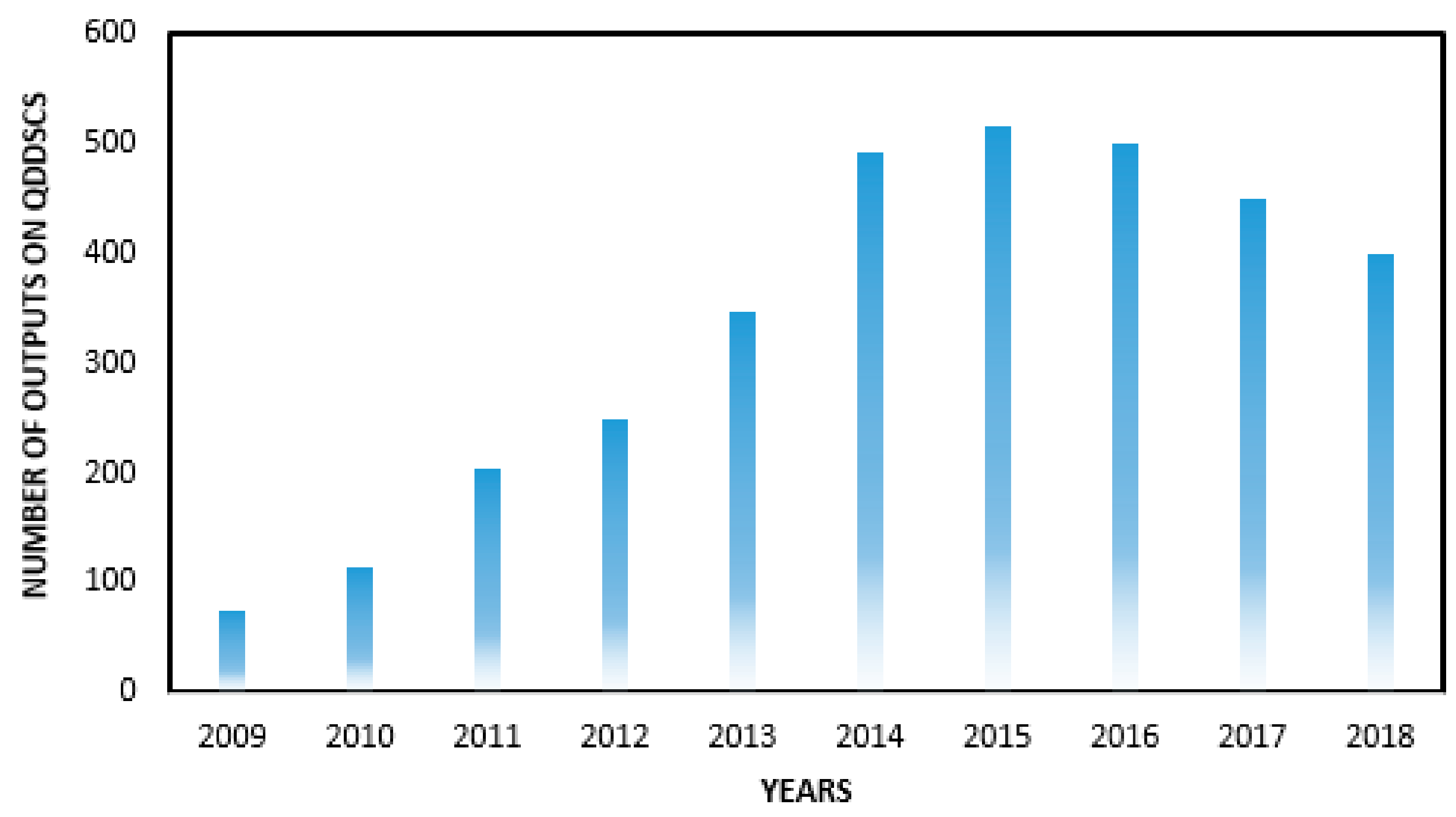
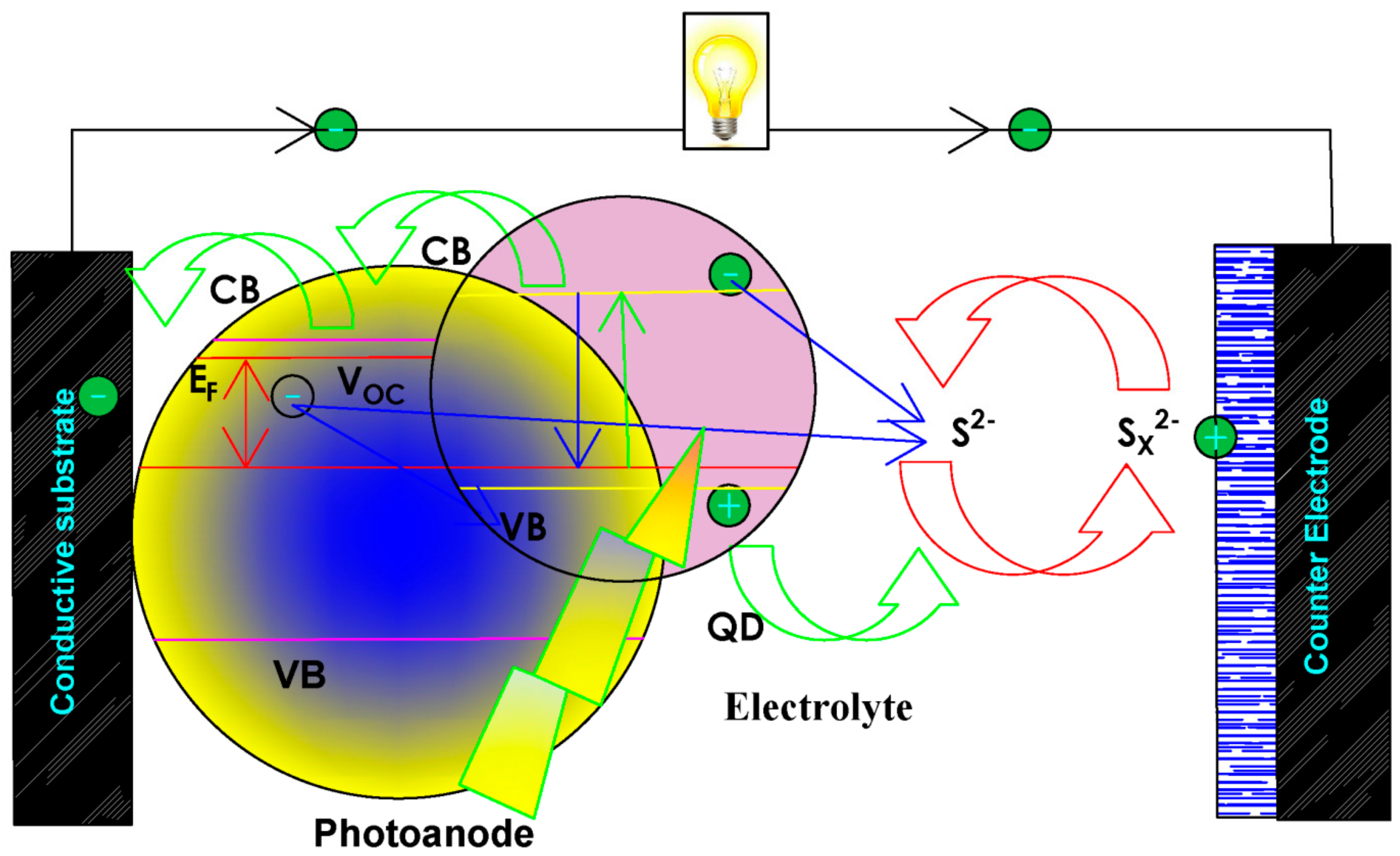

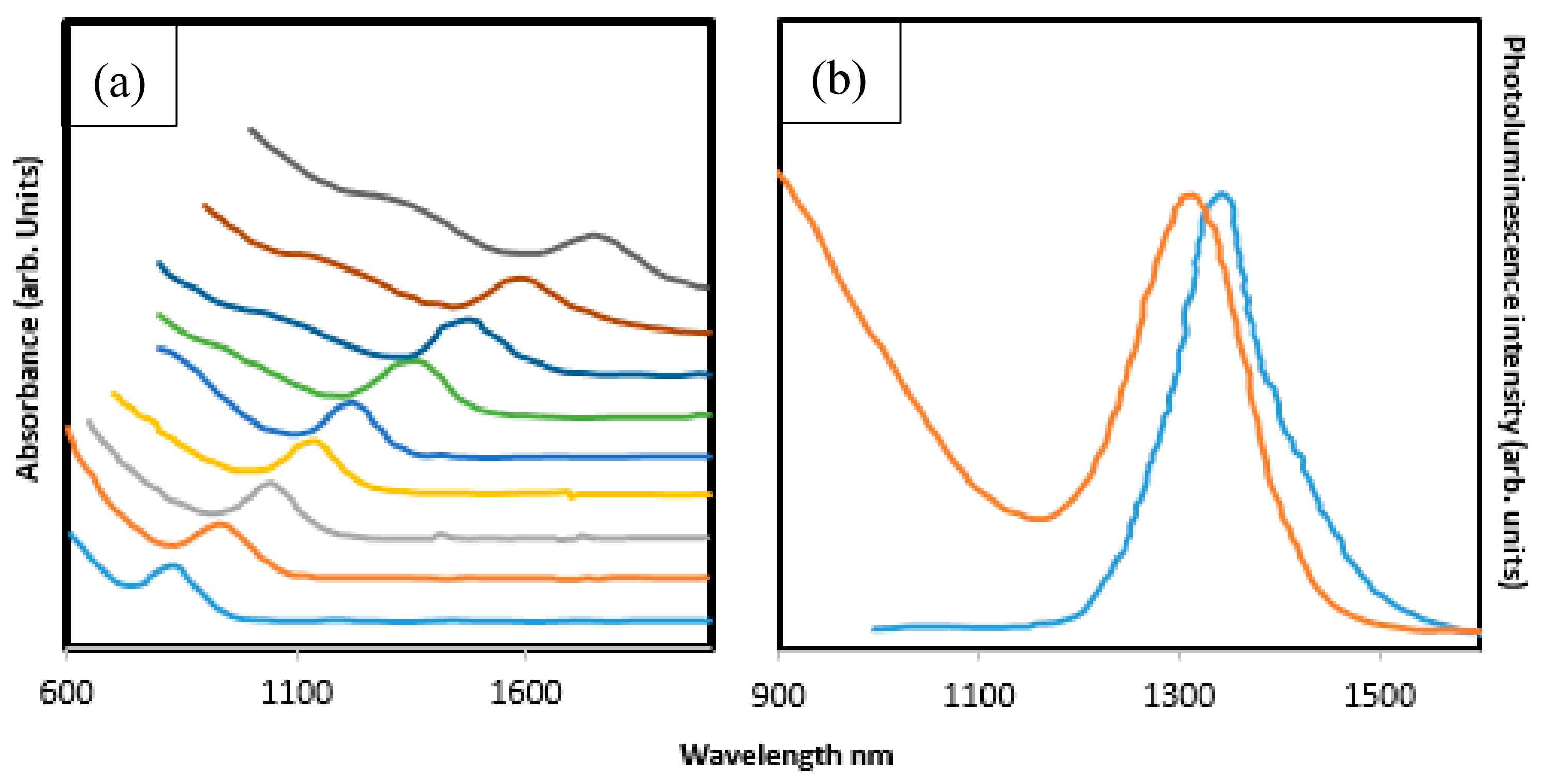
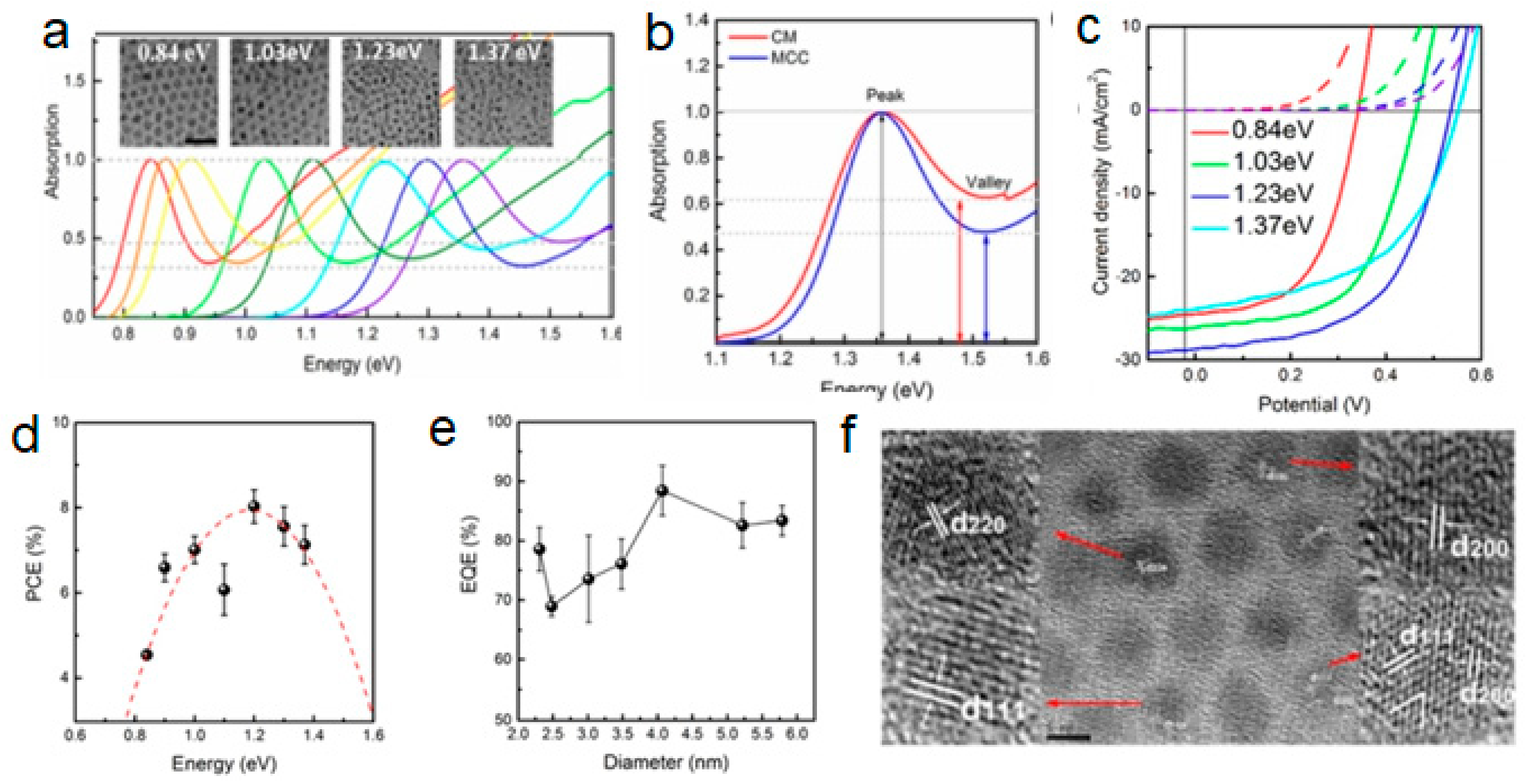
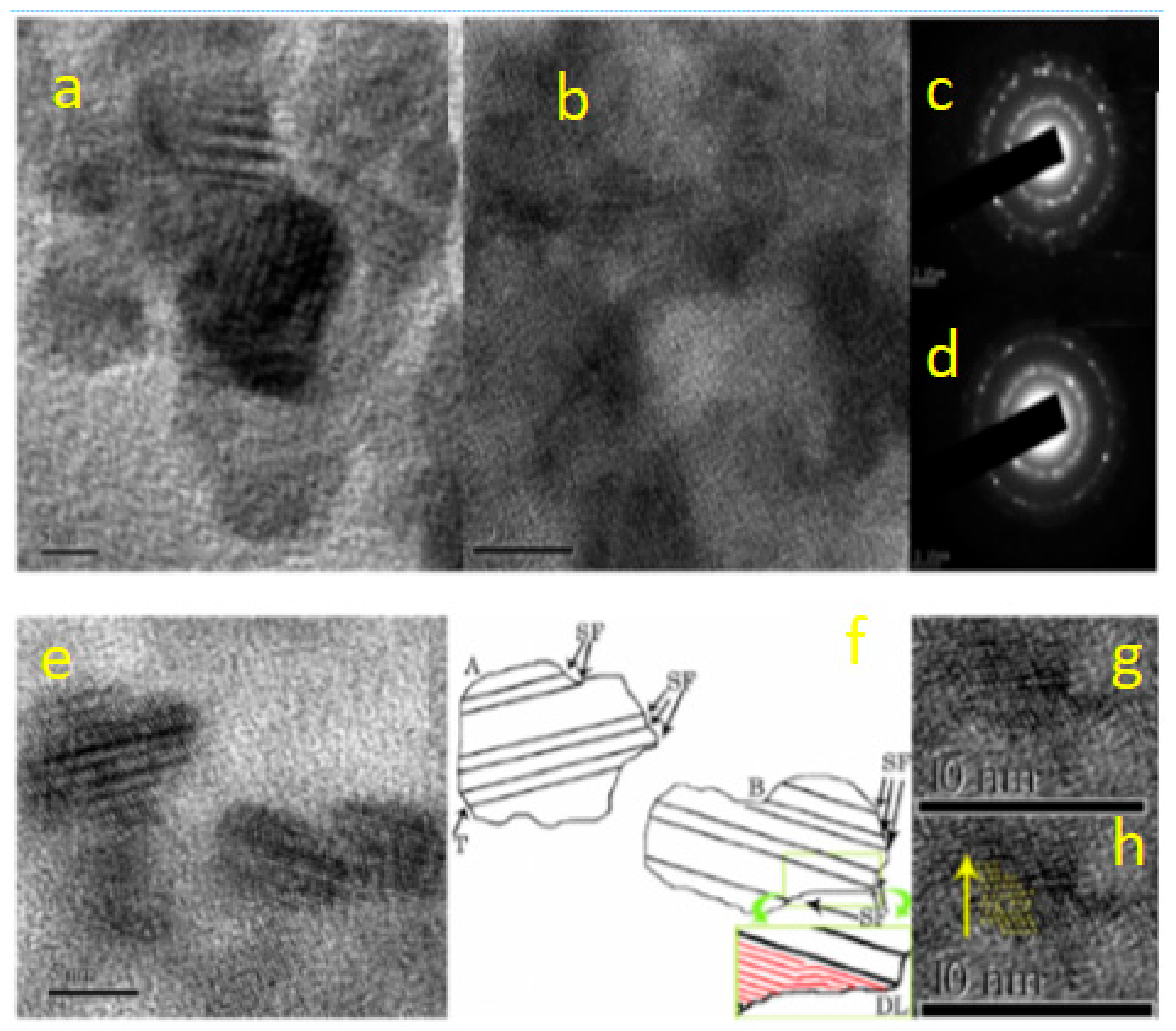

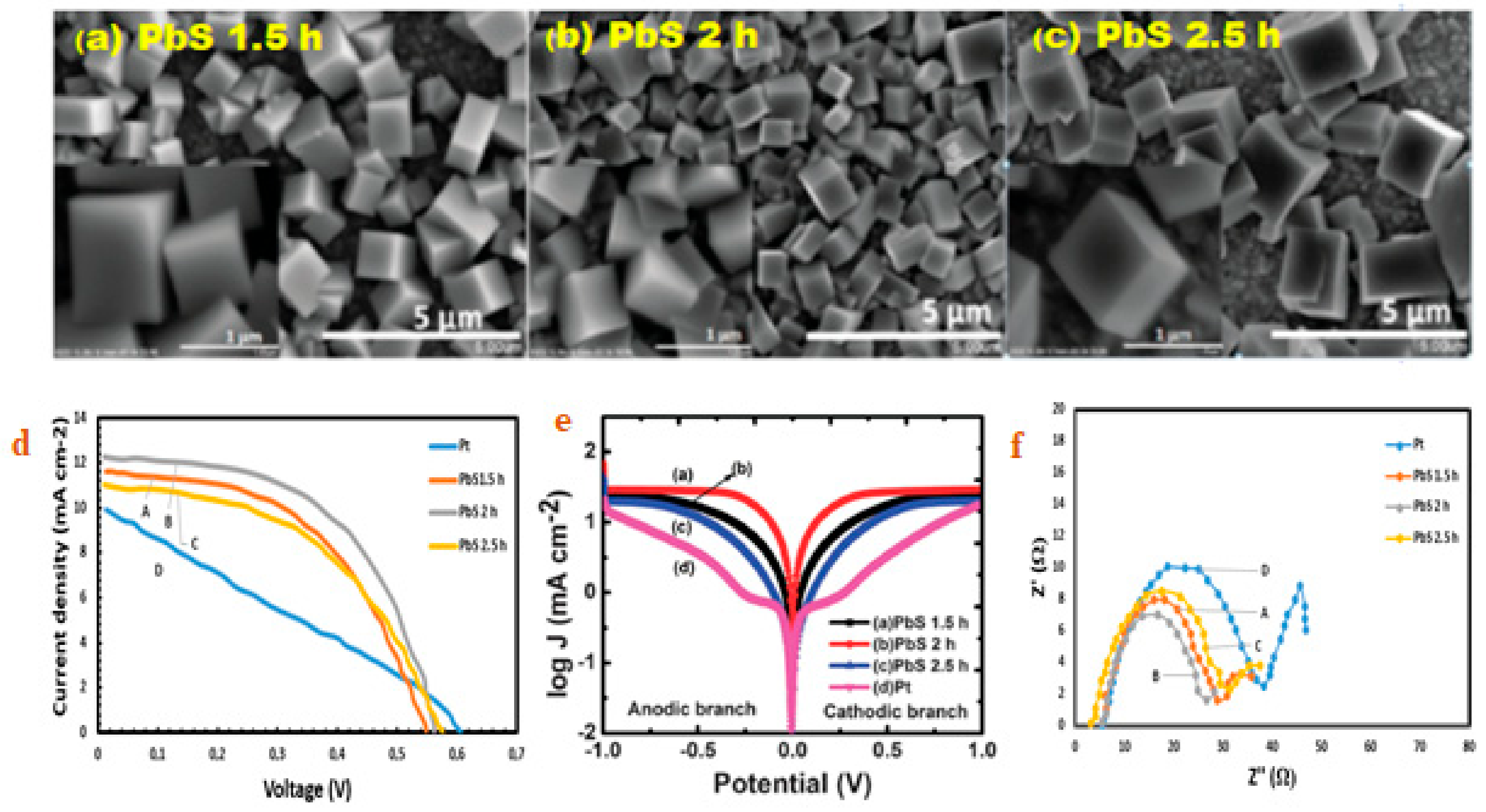
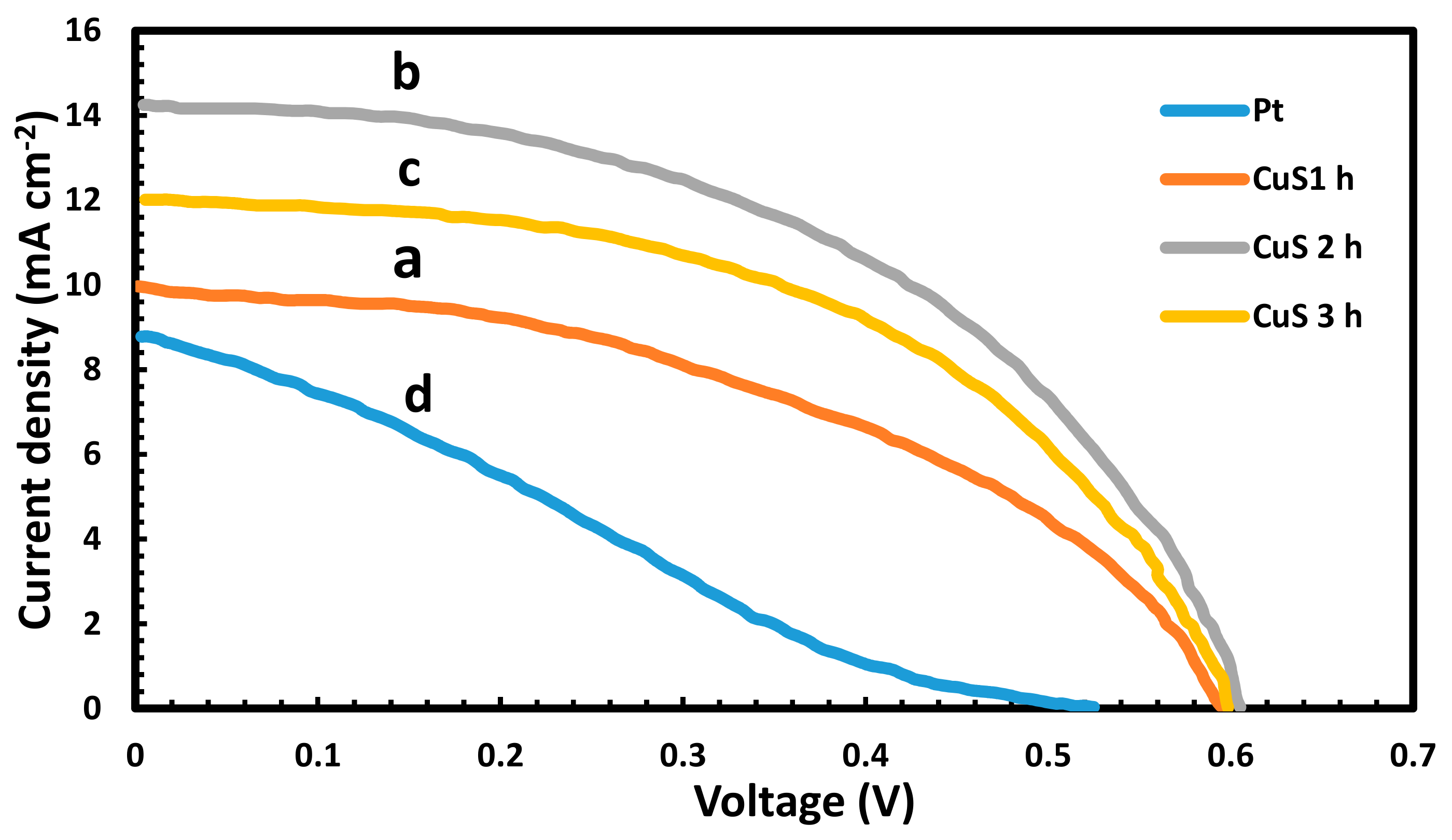
| Quantum Dots | Photoanode | Electrolyte | CEs | ECE (%) | Year | Ref. |
|---|---|---|---|---|---|---|
| CuS | TiO2/CdS/CdSe/ZnS | S2−/Sx2− | Pt | 3.18 | 2015 | [29] |
| Cu2S-CBD/N719 | TiO2 | 4-tert-butylpyridine | Pt | 8.34 | 2016 | [30] |
| CuInSe/ZnS | TiO2 | S2−/Sx2− | Cu2S | 8.10 | 2016 | [31] |
| PbS QDs | TiO2 | S2−/Sx2− | Cu2S | 2.24 | 2016 | [32] |
| PbS/CdS/ZnS | TiO2 | S2−/Sx2− | Cu2S | 7.19 | 2016 | [33] |
| PbS | TiO2 | S2−/Sx2− | Cu2S | 1.30 | 2018 | [34] |
| PbS CQD | ZnO | TBAI | Carbon | 3.6 | 2017 | [35] |
| SnS QDs | TiO2 | 4-tert-butylpyridine | Pt | 0.326 | 2015 | [36] |
| SnS | TiO2 | 4-tert-butylpyridine | Au | 0.0102 | 2014 | [37] |
| SnS QDs | TiO2 | S2−/Sx2− | Pt | 0.072 | 2019 | [38] |
| Cell | VOC (mV) | JSC (mA/cm2) | FF (%) | H (%) | RS (kΩ cm2) | RSH (kΩ cm2) | n | J0 × 10−7 (mA/cm2) | Year | Ref. |
|---|---|---|---|---|---|---|---|---|---|---|
| CuS5/FTO5 μm | 0.37 | 5.81 | 52 | 1.12 | 13.6 | 26.2 | - | - | 2017 | [116] |
| CuS 2h | 0.612 | 15.52 | 0.452 | 4.29 | 7.65 | 1.68 | 1.33 | 2.676 | 2017 | [117] |
| CuS/NF | 0.61 | 17.8 | 0.54 | 4.93 | 7.4 | 7.26 | 2.1 | - | 2017 | [118] |
| CuS | 0.58 | 0.71 | 48 | 1.38 | - | - | - | - | 2017 | [119] |
| CuS | 688 | 9.37 | 67 | 4.31 | - | - | - | - | 2019 | [120] |
| PbS90 | 0.644 | 12.17 | 0.588 | 4.61 | 7.56 | 1.45 | 0.5 | 5.01 | 2015 | [121] |
| ITO/PbS-TBAI/Al | 0.45 | 17.86 | 52.0 | 4.18 | - | - | - | - | 2017 | [122] |
| PbS 2 h | 0.560 | 11.20 | 0.55 | 3.48 | 8.58 | 2.6 | 1.21 | 3.04 | 2015 | [123] |
| PbS | 495 | 17.46 | 0.639 | 5.52 | - | - | - | - | 2019 | [124] |
| PbS/CuS/HNS QD | 0.61 | 23.8 | 64.4 | 9.3 | - | - | - | - | 2019 | [125] |
| PbS QD | 0.56 | 25.01 | 67.3 | 9.43 | - | - | - | - | 2018 | [111] |
| SnS | 0.39 | 1.7 | 0.72 | 2.36 | - | - | - | - | 2017 | [126] |
| SnS QDs | 342 | 78 | 38.2 | 0.0102 | - | - | - | - | 2014 | [44] |
| Mo/SnS/CdS/i-ZnO/ITO | 290 | 17.2 | 56 | 2.8 | - | - | - | - | 2019 | [127] |
| SnS-S | 746 | 18.09 | 0.67 | 8.96 | - | - | - | - | 2019 | [128] |
| FTO/πSnS/CdS/i-ZnO/ITO | 113 | 3.40 | 42 | 0.15 | - | - | - | - | 2018 | [129] |
© 2019 by the authors. Licensee MDPI, Basel, Switzerland. This article is an open access article distributed under the terms and conditions of the Creative Commons Attribution (CC BY) license (http://creativecommons.org/licenses/by/4.0/).
Share and Cite
Meyer, E.L.; Mbese, J.Z.; Agoro, M.A. The Frontiers of Nanomaterials (SnS, PbS and CuS) for Dye-Sensitized Solar Cell Applications: An Exciting New Infrared Material. Molecules 2019, 24, 4223. https://doi.org/10.3390/molecules24234223
Meyer EL, Mbese JZ, Agoro MA. The Frontiers of Nanomaterials (SnS, PbS and CuS) for Dye-Sensitized Solar Cell Applications: An Exciting New Infrared Material. Molecules. 2019; 24(23):4223. https://doi.org/10.3390/molecules24234223
Chicago/Turabian StyleMeyer, Edson L., Johannes Z. Mbese, and Mojeed A. Agoro. 2019. "The Frontiers of Nanomaterials (SnS, PbS and CuS) for Dye-Sensitized Solar Cell Applications: An Exciting New Infrared Material" Molecules 24, no. 23: 4223. https://doi.org/10.3390/molecules24234223
APA StyleMeyer, E. L., Mbese, J. Z., & Agoro, M. A. (2019). The Frontiers of Nanomaterials (SnS, PbS and CuS) for Dye-Sensitized Solar Cell Applications: An Exciting New Infrared Material. Molecules, 24(23), 4223. https://doi.org/10.3390/molecules24234223







